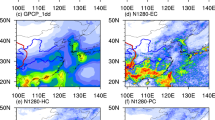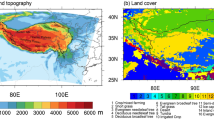Abstract
Overestimation of precipitation over steep mountains has been a long-lasting bias in many climate models. After replacing the semi-Lagrangian method with a finite-difference approach for trace transport algorithm (the two-step shape preserving scheme, TSPAS), the modified NCAR CAM5 (M-CAM5) with high horizontal resolution results in a significant improvement of simulation in precipitation over the steep edge of the Tibetan Plateau. The M-CAM5 restrains the “overshoot” of water vapor to the high-altitude region of the windward slopes and significantly reduces the overestimation of precipitation in areas above 2000 m along the southern edge of the Tibetan Plateau. More moisture are left in the low-altitude region on the slope where used to present dry biases in CAM5. The excessive (insufficient) amount of precipitation over the higher (lower) part of the steep slope is partially caused by the multi-grid water vapor transport in CAM5, which leads to spurious accumulation of water vapor at cold and high-altitude grids. Benefited from calculation of transport grid by grid in TSPAS and detailed description of steep mountains by the high-resolution model, M-CAM5 moves water vapor and precipitation downward over windward slopes and presents a more realistic simulation. Results in this study indicate that in addition to the development of physical parameterization schemes, the dynamical process should also be reconsidered in order to improve the climate simulation over steep mountains.











Similar content being viewed by others
References
Alves LM, Marengo J (2010) Assessment of regional seasonal predictability using the precis regional climate modeling system over South America. Theor Appl Climatol 100(3–4):337–350
Bretherton CS, Park S (2009) A new moist turbulence parameterization in the community atmosphere model. J Clim 22(12):3422–3448
Codron F, Sadourny R (2002) Saturation limiters for water vapour advection schemes: impact on orographic precipitation. Tellus A 54(4):338–349
Danard M, Zhang Q, Kozlowski J (1993) On computing the horizontal pressure gradient force in sigma coordinates. Mon Weather Rev 121(11):3173–3183
Gulizia C, Camilloni I (2014) Comparative analysis of the ability of a set of CMIP3 and CMIP5 global climate models to represent precipitation in South America. Int J Climatol. doi:10.1002/joc.4005
Huffman GJ, Adler RF, Bolvin DT, Gu G, Nelkin EJ, Bowman KP, Hong Y, Stocker EF, Wolff DB (2007) The TRMM multisatellite precipitation analysis (TMPA): quasi-global, multiyear, combined-sensor precipitation estimates at fine scales. J Hydrometeorol 8(1):38–55
Mehran A, AghaKouchak A, Phillips T (2014) Evaluation of CMIP5 continental precipitation simulations relative to satellite-based gauge-adjusted observations. J Geophys Res: Atmos 119(4):1695–1707
Mlawer EJ, Taubman SJ, Brown PD, Iacono MJ, Clough SA (1997) Radiative transfer for inhomogeneous atmospheres: RRTM, a validated correlated-k model for the longwave. J Geophys Res 102(D14):16,663–16
Morrison H, Gettelman A (2008) A new two-moment bulk stratiform cloud microphysics scheme in the community atmosphere model, version 3 (CAM3). Part I: description and numerical tests. J Clim 21(15):3642–3659
Neale RB, Chen C, Gettelman A, Lauritzen P, Park S, Williamson D, Conley A, Garcia R, Kinnison D, Lamarque J, et al. (2010) Description of the ncar community atmosphere model (CAM 5.0). NCAR Tech Note NCAR/TN-486+ STR
Park S, Bretherton CS (2009) The University of Washington shallow convection and moist turbulence schemes and their impact on climate simulations with the community atmosphere model. J Clim 22(12):3449–3469
Richter JH, Rasch PJ (2008) Effects of convective momentum transport on the atmospheric circulation in the community atmosphere model, version 3. J Clim 21(7):1487–1499
Staniforth A, Côté J (1991) Semi-Lagrangian integration schemes for atmospheric models–a review. Mon Weather Rev 119(9):2206–2223
Su F, Duan X, Chen D, Hao Z, Cuo L (2013) Evaluation of the global climate models in the CMIP5 over the Tibetan Plateau. J Clim 26(10):3187–3208
Tao S, Chen L (1987) A review of recent research on the East Asian summer monsoon in China. In: Chang C, Krishnamurti T (eds) Monsoon meteorology. Oxford University Press, Oxford, pp 60–92
Wang B, Lin H (2002) Rainy season of the Asian-Pacific summer monsoon. J Clim 15(4):386–398
Wu L, Zhai P (2012) Validation of daily precipitation from two high-resolution satellite precipitation datasets over the Tibetan Plateau and the regions to its east. Acta Meteorol Sin 6:735–745
Xu Y, Gao X, Giorgi F (2010) Upgrades to the reliability ensemble averaging method for producing probabilistic climate-change projections. Clim Res 41(1):61–81
Yu R (1994) A twostep shapepreserving advection scheme. Adv Atmos Sci 11(4):479–490
Zhang GJ, McFarlane NA (1995) Sensitivity of climate simulations to the parameterization of cumulus convection in the Canadian Climate Centre general circulation model. Atmos-Ocean 33(3):407–446
Zhang Y, Yu R, Li J, Chen H (2013) An implementation of a leaping-point Two-step Shape-Preserving Advection Scheme in the high-resolution spherical latitude-longitude grid. Acta Meteorol Sin 71(6):1089–1102
Acknowledgments
Two anonymous reviewers are gratefully acknowledged for their thoughtful comments and suggestions. This research was supported by the Major National Basic Research Program of China (973 Program) on Global Change under Grant 2010CB951902, the National Natural Science Foundation of China under Grant Nos. 41221064, 41322034, and the Basic Scientific Research and Operation Foundation of CAMS under Grant No. 2013Z004.
Author information
Authors and Affiliations
Corresponding author
Rights and permissions
About this article
Cite this article
Yu, R., Li, J., Zhang, Y. et al. Improvement of rainfall simulation on the steep edge of the Tibetan Plateau by using a finite-difference transport scheme in CAM5. Clim Dyn 45, 2937–2948 (2015). https://doi.org/10.1007/s00382-015-2515-3
Received:
Accepted:
Published:
Issue Date:
DOI: https://doi.org/10.1007/s00382-015-2515-3




